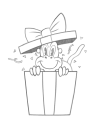Give a gift
Give a gift card for art students to use on anything in the Proko store.
Or gift this course:

About instructor
Founder of Proko, artist and teacher of drawing, painting, and anatomy. I try to make my lessons fun and ultra packed with information.


















Assignment
Use the images provided in the downloads to draw the Robo Bean and Anato Bean. Then add the oblique with the correct stretching, pinching, or twisting. Think about the motion and how the motion deforms the shape of the muscle.